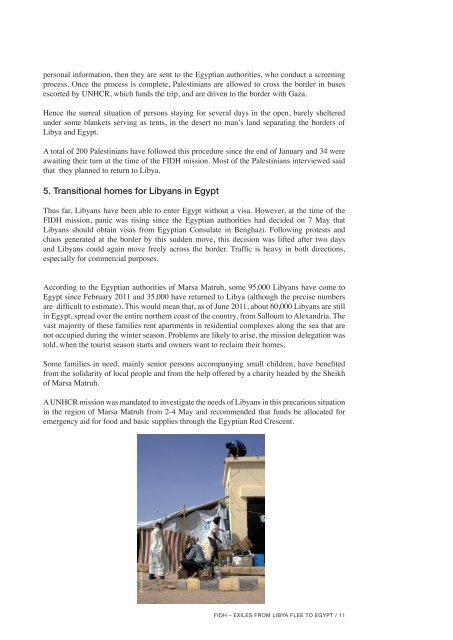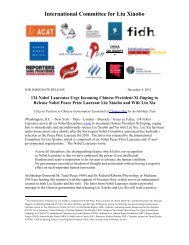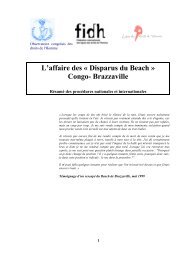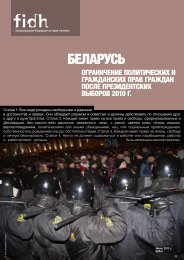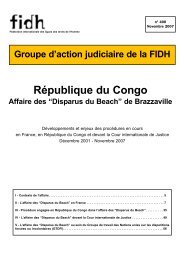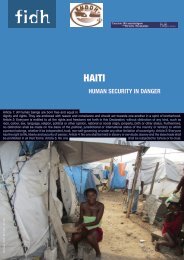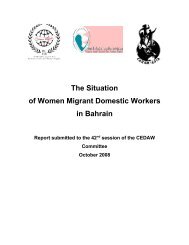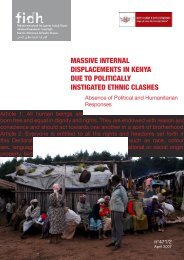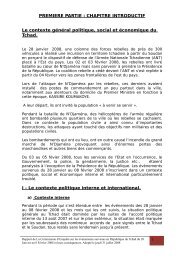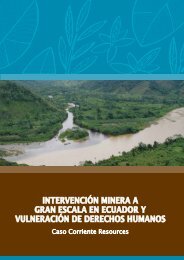----3 officers and a supervisor for procedures pertaining <strong>to</strong> resettlement in third countries2 protection officers3 or 4 interpreters1 coordina<strong>to</strong>rInterviews are conducted by officers in small rooms in the administrative buildings at a rateof 6 per day, 5 days per week. Recommendations for acceptance or rejection are sent <strong>to</strong> thesupervisor for a decision. If rejected at first instance, applicants are provided with an oralexplanation of the reasons for refusal and are au<strong>to</strong>matically given an appeal interview withinone week. Another officer is in charge of the second appeal hearing and the coordina<strong>to</strong>r takesthe final decision.As of 10 May, 218 people (out of 609) had undergone the Refugee Status Determinationprocedure, with a recognition rate of 78%.Once recognized as refugees, individuals meet the officers in charge of resettlement, and thewait may be much longer before being accepted in<strong>to</strong> a host country.As of the beginning of June 2011, Sweden had provided 150 spaces: a Swedish mission was onsite <strong>to</strong> review applications. Departures were scheduled for mid-June.The United States of America had pledged <strong>to</strong> take 200 refugees. A mission was scheduled <strong>to</strong>arrive soon for interviews, but the security screening procedures are very long for the UnitedStates, approximately 6 months. UNHCR is negotiating for these refugees, pending a finaldecision of the United States, <strong>to</strong> be transferred <strong>to</strong> a transit shelter in Timisoara, Romania.UNHCR teams reported being subjected <strong>to</strong> dual pressure:• The <strong>Egypt</strong>ian authorities insist that departures speed up and that the Salloum Land Portis not transformed in<strong>to</strong> a refugee camp;• Asylum seekers who have just gone through a second traumatic experience in <strong>Libya</strong>,following the experiences which caused them <strong>to</strong> <strong>flee</strong> in their home countries, areparticularly anxious about their fate, not <strong>to</strong> mention the deplorable living conditionsat Salloum.It is the responsibility of states in the North, and particularly all those who have committed <strong>to</strong>NATO’s military operations “<strong>to</strong> protect civilians” under United Nations Resolution 1973, <strong>to</strong>protect these other civilian victims of the <strong>Libya</strong>n conflict, who are living in precarious conditionsat the <strong>Libya</strong>n border. Concretely, this requires new and more generous funding for operations ofrepatriation of migrants, as well as offers <strong>to</strong> host refugees (a little over 3,000 people, includingrefugees at the borders in <strong>Egypt</strong> and Tunisia).4. Palestinians kept in no man’s landDuring the reign of President Hosni Mubarak, the entry of Palestinians on <strong>Egypt</strong>ian terri<strong>to</strong>rywas strictly limited. In fact, according <strong>to</strong> the Palestinians met in Salloum, it was impossible forPalestinian residents in <strong>Libya</strong> <strong>to</strong> pass the land border; one man had tried 8 times over 30 yearsbut had been turned back at every attempt.These strict controls persist and Palestinians are not allowed <strong>to</strong> enter <strong>Egypt</strong>: they must wait inno man’s land before being transported directly <strong>to</strong> the Gaza border.But, since the fall of Mubarak, it is possible <strong>to</strong> obtain permits <strong>to</strong> enter Palestine by the Rafahcrossing in southern Gaza. To obtain these permits allowing passage through <strong>Egypt</strong>, applicantsmust first contact by phone the representation of the Palestinian Authority in Cairo and provide10 / EXILES FROM LIBYA FLEE TO EGYPT – <strong>FIDH</strong>
personal information, then they are sent <strong>to</strong> the <strong>Egypt</strong>ian authorities, who conduct a screeningprocess. Once the process is complete, Palestinians are allowed <strong>to</strong> cross the border in busesescorted by UNHCR, which funds the trip, and are driven <strong>to</strong> the border with Gaza.Hence the surreal situation of persons staying for several days in the open, barely shelteredunder some blankets serving as tents, in the desert no man’s land separating the borders of<strong>Libya</strong> and <strong>Egypt</strong>.A <strong>to</strong>tal of 200 Palestinians have followed this procedure since the end of January and 34 wereawaiting their turn at the time of the <strong>FIDH</strong> mission. Most of the Palestinians interviewed saidthat they planned <strong>to</strong> return <strong>to</strong> <strong>Libya</strong>.5. Transitional homes for <strong>Libya</strong>ns in <strong>Egypt</strong>Thus far, <strong>Libya</strong>ns have been able <strong>to</strong> enter <strong>Egypt</strong> without a visa. However, at the time of the<strong>FIDH</strong> mission, panic was rising since the <strong>Egypt</strong>ian authorities had decided on 7 May that<strong>Libya</strong>ns should obtain visas <strong>from</strong> <strong>Egypt</strong>ian Consulate in Benghazi. Following protests andchaos generated at the border by this sudden move, this decision was lifted after two daysand <strong>Libya</strong>ns could again move freely across the border. Traffic is heavy in both directions,especially for commercial purposes.According <strong>to</strong> the <strong>Egypt</strong>ian authorities of Marsa Matruh, some 95,000 <strong>Libya</strong>ns have come <strong>to</strong><strong>Egypt</strong> since February 2011 and 35,000 have returned <strong>to</strong> <strong>Libya</strong> (although the precise numbersare difficult <strong>to</strong> estimate). This would mean that, as of June 2011, about 60,000 <strong>Libya</strong>ns are stillin <strong>Egypt</strong>, spread over the entire northern coast of the country, <strong>from</strong> Salloum <strong>to</strong> Alexandria. Thevast majority of these families rent apartments in residential complexes along the sea that arenot occupied during the winter season. Problems are likely <strong>to</strong> arise, the mission delegation was<strong>to</strong>ld, when the <strong>to</strong>urist season starts and owners want <strong>to</strong> reclaim their homes.Some families in need, mainly senior persons accompanying small children, have benefited<strong>from</strong> the solidarity of local people and <strong>from</strong> the help offered by a charity headed by the Sheikhof Marsa Matruh.A UNHCR mission was mandated <strong>to</strong> investigate the needs of <strong>Libya</strong>ns in this precarious situationin the region of Marsa Matruh <strong>from</strong> 2-4 May and recommended that funds be allocated foremergency aid for food and basic supplies through the <strong>Egypt</strong>ian Red Crescent.© Gael Grilhot<strong>FIDH</strong> – EXILES FROM LIBYA FLEE TO EGYPT / 11


